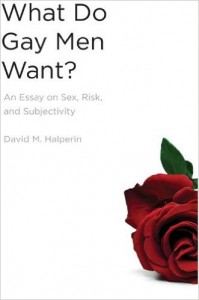 What Do Gay Men Want? An Essay on Sex, Risk, and Subjectivity
What Do Gay Men Want? An Essay on Sex, Risk, and Subjectivity
by David M. Halperin
University of Michigan Press. 167 pages, $22.95
DAVID HALPERIN has a distinguished history of setting aside accepted ways of thinking about gay men’s issues and examining them anew with a clarity and rigor that produce valuable and sometimes surprising insights. This was true of his books on how Western culture has viewed same-sex-attracted men in the past, One Hundred Years of Homosexuality (1990) and How To Do the History of Homosexuality (2002). It is no less true of his latest, which asks us to re-examine how certain segments of society are reacting to gay men and AIDS today.
Halperin begins by examining how medicine and the media have dealt with reports of gay men having unprotected anal sex in the time of AIDS.
Halperin does not accept the idea that gay men who have unprotected sex are necessarily unbalanced. Instead, he asks us to consider that risk-taking of one sort or another is a part of ordinary human behavior. If a man with a history of high cholesterol sometimes neglects to take his medicine or goes off his low-cholesterol diet, for example, he is not regarded as insane—self-indulgent or careless, perhaps, but not pathological. In the case of gay sex, however, Halperin argues that we have accepted an abnormally severe judgment on risky but not inevitably fatal behavior—an ethic of risk elimination instead of risk reduction, as he phrases it. This has “made it impossible for gay men to admit openly to having unprotected anal intercourse even on occasion without … incurring the blame, shame, and guilt directed at them by other, less risk-tolerant (or less candid) gay men,” thereby pre-empting any meaningful discussion of risk reduction with those who would benefit from it.
This intolerance of risk is a real problem for gay men, Halperin argues, because they’re often particularly attracted to risk as a result of the way they’ve been treated: “the affective structure of gay male subjectivity itself, shaped by ordinary social experiences of rejection and shame, [is]bristling with impulses to transgression.” Using works of French writer Jean Genet, Halperin develops the concept of abjection as a non-psychological way of describing gay men’s behavior. “Abjection is an extreme form of disidentification,” he explains, one through which gay men have found a way to “transcend social humiliation and attain … a perverse exaltation” by changing the values general society assigns to certain things in order to protect their psyche from the attacks of a sometimes hostile environment. “[A]bjection achieves a spiritual release from domination by derealizing its humiliating effects—by depriving domination of its ability to demean the subject.”
For Halperin, viewing gay men’s sexual risk-taking as a form of abjection “offers a way of understanding the motivation of marginalized individuals without representing their acts as either intentional or unintentional.” It therefore provides a way of viewing gay men’s actions without the sort of normalizing psychology-based judgments that now isolate them from any intelligent discussion of risk reduction in human, livable terms. “The smug moralism and righteous self-congratulation of those (straight or gay) people who pride themselves on being normal” does nothing to get gay men who take risks to discuss with others openly and freely how they might do so in the best fashion. Instead, it only isolates them in a new and very unhealthy closet. What we need is an “authorized discourse of hiv/aids risk reduction,” Halperin argues, and not “the unrealistic, panicky, and outdated strategy of risk elimination.” But we cannot move in that direction so long as we accept explanations of human action that brand non-normative behavior as sick or irresponsible.
Halperin makes his arguments and supports them clearly and convincingly, with plenty of documentation: there are 41 pages of footnotes for 109 pages of text. The footnotes do not need to be read to follow the arguments, however; they are there strictly to document his sources. While I find the idea of abjection unconvincing as a universal explanation of gay risk-taking, this slim volume did change my way of viewing gay men in the context of how we’re treated—in two senses of the word—by the medical establishment and by the popular press.
____________________________________________________________________
Richard M. Berrong, professor of French at Kent State, is the author of In Love with a Handsome Sailor, about the novels of Pierre Loti.





